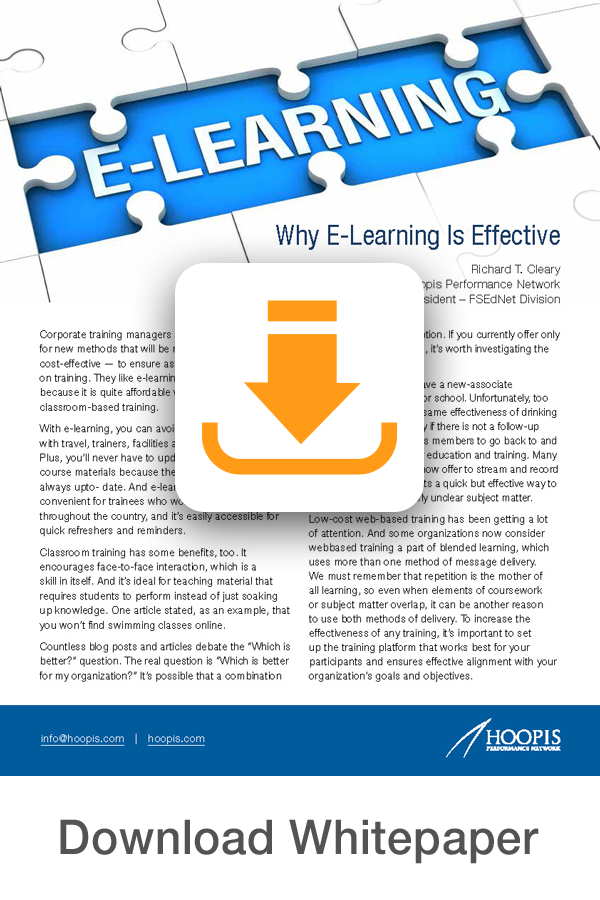Why E-Learning Is Effective

Corporate training managers are constantly searching for new methods that will be more effective — and cost-effective — to ensure as high a return as possible on training. They like e-learning, or online training, because it is quite affordable when compared with classroom-based training.
With e-learning, you can avoid expenses associated with travel, trainers, facilities and course materials. Plus, you’ll never have to update, correct or reprint course materials because the online versions are always upto- date. And e-learning is far more convenient for trainees who work in different offices throughout the country, and it’s easily accessible for quick refreshers and reminders.
Classroom training has some benefits, too. It encourages face-to-face interaction, which is a skill in itself. And it’s ideal for teaching material that requires students to perform instead of just soaking up knowledge. One article stated, as an example, that you won’t find swimming classes online.
Countless blog posts and articles debate the “Which is better?” question. The real question is “Which is better for my organization?” It’s possible that a combination of the two is your best option. If you currently offer only classroom-based training, it’s worth investigating the benefits of e-learning.
Many organizations will have a new-associate orientation, training class or school. Unfortunately, too often these can have the same effectiveness of drinking from a fire hose, especially if there is not a follow-up resource available for class members to go back to and obtain the same or similar education and training. Many colleges and universities now offer to stream and record lectures, providing students a quick but effective way to review or clarify particularly unclear subject matter.
Low-cost web-based training has been getting a lot of attention. And some organizations now consider webbased training a part of blended learning, which uses more than one method of message delivery. We must remember that repetition is the mother of all learning, so even when elements of coursework or subject matter overlap, it can be another reason to use both methods of delivery. To increase the effectiveness of any training, it’s important to set up the training platform that works best for your participants and ensures effective alignment with your organization’s goals and objectives.
Specific Benefits of E-Learning
Depending on the material, e-learning can be highly successful, especially with younger people who are accustomed to learning material online. Here are some points to consider:
- Every dollar invested in online training results in a $30 increase in productivity.
- Companies that use e-learning technology achieve an average 18 percent boost in employee engagement.
- Forty percent of employees who receive poor job training leave their positions within the first year.
- E-learning boosts retention rates by 25 to 60 percent, compared to retention rates of 8 to 10 percent with traditional training.
- It typically takes employees 40 to 60 percent less time to study material via e-learning than in a traditional classroom setting.
- IBM found that participants learned nearly five times more material without increasing time spent in training. The corporation saved approximately $200 million after switching to e-learning.
- A 2017 report revealed that 42 percent of companies say that eLearning has led to an increase in revenue.
Organizations that use e-learning are also likely to enjoy such benefits as convenience, standardized delivery and the ability for students to progress according to their pace of learning and availability.
Now let’s look at how to implement e-learning in your company or firm.
Implementing E-Learning
To achieve their goals and objectives, an organization’s leaders must plan effectively. It can seem overwhelming to change your entire training program, especially if you have invested a lot in it and have been using it for a long time. Here are some ways to ease into the e-learning process.
- Define your goals. Knowing what you want the training to accomplish will help determine what type of training you need. For example, your goal might be to teach new sales leaders how to manage a budget or to teach mid-level advisors how to break performance plateaus.
- Set a budget. It’s easy to get enamored with a new training platform that sounds too good to be true. Setting a budget in advance should keep you from overspending.
- Ask around. At industry meetings, in study groups and through social media sites like LinkedIn, find out which training programs have worked well for companies or firms that are structured similar to yours. Word-of-mouth referrals are always superior to trial and error.
- Start small. You don’t want to replace your entire training program with something new and unproven. Try out an online course with either a group of your sales leaders or advisors, or have the whole team try it. Experiment. Once you find something most people seem to like, consider expanding your offerings on that platform.
- Promote the training and follow up. To maximize the benefit and results of any e-learning curriculum, it cannot be a “set it and forget it” strategy. The organization’s leadership must not only promote this resource but must follow up and assign early usage to instill top-of-mind remembrance of this tool and its benefit.
- Measure your results. Have participants fill out a survey after each training program to gauge their reaction to it. Find out to what extent they were engaged, how valuable they thought it was, how much they will actually use the material in their work and how likely they would be to recommend it to someone else or want to take that type of training again. Also measure your ROI. After six months or a year, evaluate how much your organization benefited from it, compared with how much you spent on it.
An Easy Way to Try E-Learning
With today’s demand for work/life balance, you want your training to be available 24/7 so you can sharpen sales leaders’ and advisors’ skills on demand.
A highly efficient and effective way to dip your toes into the e-learning water is through Hoopis performance Network. Your sales leaders and advisors can access training and information on their smartphones and tablets when they have some spare time. Sometimes they get to an appointment 10 minutes early to beat traffic, and they want to brush up on their skills rather than waste that time. In those 10 minutes, they can watch one of hundreds of training sessions that can help them keep their saws sharp as they prepare for a joint sales call or recruit another top performer to the firm. They get to learn new skills during what used to be down time.
HPN brings you winning training for sales associates, and sales leaders. All participants get to learn at their own pace. Also, they can customize their curriculum to what interests them the most, or the company or firm can decide on the order of their learning.



